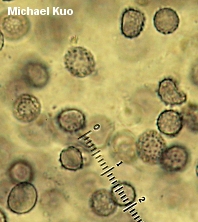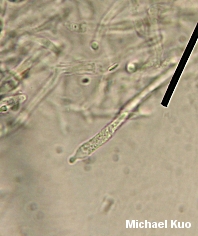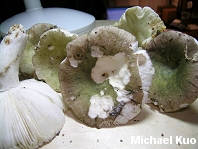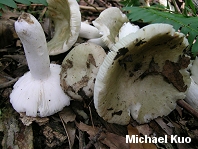Russula cyanoxantha (MushroomExpert.Com) (original) (raw)
Russula cyanoxantha
[ Basidiomycetes > Russulales > Russulaceae > Russula . . . ]
by Michael Kuo
Apparently widely distributed in North America, Russula cyanoxantha is characterized by a combination of features:
- A cap that is purple to green (or, more commonly, mottled with these colors) and often features fine radial veins;
- A white spore print;
- Mild taste;
- Gills that are flexible and greasy when young, and usually forked only near the stem, if at all.
Eastern North America's Russula variata is very similar but can theoretically be separated on the basis of its repeatedly and conspicuously forking gills and its often acrid taste; additionally, its cap surface lacks the radial veins often found on Russula cyanoxantha and, under the microscope, its pileipellis lacks pseudocystidia that are yellowish in KOH.
There may be several distinct north American mushrooms currently being labeled "Russula cyanoxantha," and they may not actually be the same as the European species that properly owns the name.
Description:
Ecology: Mycorrhizal with hardwoods or conifers; growing alone, scattered, or gregariously; summer and fall; widely distributed in North America.
Cap: 4-15 cm; convex when young, becoming broadly convex to flat with a shallow depression; dry or slightly moist; smooth, but often finely veined in radial patterns; pinkish purple to green or olive green--or with these and other shades mottled; the margin usually not lined; the skin peeling about halfway to the center.
Gills: Attached or slightly running down the stem; close or nearly distant; not forking, or forking occasionally; white; when young soft, greasy, and flexible (un-_Russula_-like in this regard).
Stem: 5-13 cm long; 1-3 cm thick; white, but occasionally flushed with lilac; brittle; dry; smooth.
Flesh: White; brittle; thick.
Odor and Taste: Odor not distinctive; taste mild.
Chemical Reactions: KOH on cap surface erasing pigments, then orangish. Iron salts on flesh and stem surface negative or very slightly greenish.
Spore Print: White.
Microscopic Features: Spores 6.5-9.5 x 5.5-7 µ; with isolated warts .1-.6 µ high; connectors scattered and rare, not forming reticula. Pileipellis a cutis beneath a turf-like upper layer of elements with variously shaped, slender tips; pseudocystidia narrow and fusiform to subcapitate, scattered or sometimes absent, positive in sulphovanillin and ochraceous in KOH.
REFERENCES: (Schaeffer, 1774) Fries, 1863. (Saccardo, 1887; Burlingham, 1915; Beardslee, 1918; Kauffman, 1918; Arora, 1986; Kibby & Fatto, 1990; Phillips, 1991/2005; Horn, Kay & Abel, 1993; Thiers, 1997b; McNeil, 2006.) Herb. Kuo 07220801.
This site contains no information about the edibility or toxicity of mushrooms.


© MushroomExpert.Com

